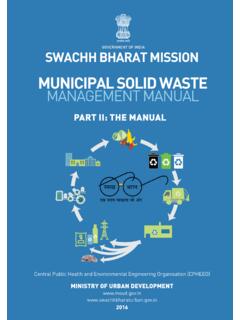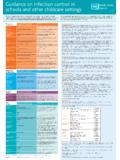Transcription of MANAGEMENT AND DISPOSAL OF BIOLOGICAL WASTE
1 MANAGEMENT AND DISPOSAL OF. BIOLOGICAL WASTE AT. TEXAS A&M INTERNATIONAL UNIVERSITY. MANAGEMENT and DISPOSAL of BIOLOGICAL WASTE TAMIU. Rev 4/99. TABLE OF CONTENTS. I. Introduction ..2. II. Responsibility 3. III. Segregation of BIOLOGICAL WASTE in the 3. IV. Containers ..3. V. Storage of BIOLOGICAL WASTE ..4. VI. Treatment of Biohazardous WASTE ..4. VII. Handling and Transporting .4. VIII. Labeling of Biohazardous WASTE .5. IX. DISPOSAL Methods ..5. X. Training and Hazard Communication 8. XI. Written Procedures and Records 8. XII. References ..9. Table 1: Treatment and DISPOSAL of Biohazardous WASTE .10. Table 2: Biohazardous WASTE Treatment Log .12. Appendix A: Definitions of Terms 13. Appendix B: Information and Assistance 15. Page 1 of 16. MANAGEMENT and DISPOSAL of BIOLOGICAL WASTE TAMIU. Rev 4/99. MANAGEMENT AND DISPOSAL OF BIOLOGICAL WASTE . AT TEXAS A&M INTERNATIONAL UNIVERSITY. I. INTRODUCTION. The purpose of this document is to provide information, requirements, guidelines and procedures for the handling and DISPOSAL of hazardous and nonhazardous BIOLOGICAL WASTE for all departments and units of the Texas A&M International University.
2 In Texas, DISPOSAL of biohazardous WASTE is regulated by the Texas Department of Health (TDH) and the Texas Natural Resource Conservation Commission (TNRCC). Local regulations of the City of Laredo also apply. " BIOLOGICAL WASTE " means discarded BIOLOGICAL material from teaching and research laboratories and operations. This does not include household or office trash, WASTE from Food Services, Physical Plant, bedding and manure from normal agricultural operations or bedding and litter from noninfectious animals. "BIOHAZARDOUS WASTE " means any solid or liquid BIOLOGICAL WASTE that is hazardous because of its physical and/or BIOLOGICAL nature and is differentiated from that which contains hazardous chemicals or radioactive materials. All WASTE that contains infectious material or which, because of its BIOLOGICAL nature, may be harmful to humans, animals, plants or the environment is biohazardous WASTE . This includes: WASTE from infectious animals; bulk human blood or blood products; infectious microbiological WASTE (including contaminated disposable culture dishes and disposable devices used to transfer, inoculate and mix cultures); pathological WASTE ; sharps; and hazardous products of recombinant DNA biotechnology and genetic manipulation.
3 Definitions of other terms used in this document can be found in APPENDIX A. Biohazardous WASTE generated at Texas A&M International University is treated by thermal or chemical disinfection, by encapsulation (solidification), or by incineration. Certain disinfected liquid WASTE may be discharged into the TAMIU Sanitary Sewer System (hereafter referred to as the Sewer System). All animal carcasses (except those contaminated with radioactive material which must be disposed of differently) and recognizable body parts must be incinerated or sent to a commercial rendering plant. All infectious material should be disinfected before removal from the laboratory. (CAUTION: Refrain from using chemical treatments that cause the WASTE to be a chemical hazard.) With exception of sharps, glassware and plastics, all infectious material should be incinerated (even after disinfection). Sharps must be segregated from other WASTE and placed in puncture resistant containers; all metallic sharps, regardless of their use, are considered biohazardous and must be encapsulated prior to DISPOSAL .
4 Liquid WASTE should be disinfected and discharged into the Sewer System. Treatment of all laboratory BIOLOGICAL WASTE prior to DISPOSAL is good laboratory practice, and is highly recommended. Biohazardous WASTE must be treated and properly labeled and records must be maintained. Personnel with potential for contact with biohazardous material must be appropriately trained. Page 2 of 16. MANAGEMENT and DISPOSAL of BIOLOGICAL WASTE TAMIU. Rev 4/99. The key requirements for DISPOSAL of TAMIU's biohazardous WASTE are that it must be (1). segregated from other WASTE ; (2) treated to eliminate the BIOLOGICAL hazard; (3) specifically labeled to indicate the method of treatment; (4) securely packaged; (5) transported to, and placed in the dumpster by appropriately trained personnel and (6) documented by maintenance of appropriate records. Biohazardous WASTE , which is mixed with hazardous chemical WASTE , radioactive WASTE , or both, must be treated to eliminate the biohazard prior to DISPOSAL .
5 After treatment, the WASTE must be managed as hazardous chemical WASTE through the TAMIU Physical Plant Department or as radioactive WASTE through the TAMIU Physical Plant Department. TABLE 1 summarizes requirements for treatment and DISPOSAL of biohazardous WASTE at TAMIU. TABLE 2 provides a model form for maintaining the record of treatment of biohazardous WASTE . Questions or written requests for any variance from these procedures should be directed to the Physical Plant Department. II. RESPONSIBILITY. The Principal Investigator, faculty member or other person with operational responsibility shall assure compliance with these requirements within his/her laboratory or area of responsibility. III. SEGREGATION OF BIOLOGICAL WASTE IN THE LABORATORY. Any WASTE that could produce laceration or puncture injuries must be disposed of as "SHARPS". Sharps must be segregated from other WASTE . Metal sharps and broken glass may be commingled with each other, but not with non-sharp WASTE .
6 WASTE that is to be incinerated should not be commingled with glass or plastics. BIOLOGICAL WASTE must not be commingled with chemical WASTE or other laboratory trash. hazardous BIOLOGICAL WASTE should be segregated from other BIOLOGICAL WASTE . IV. CONTAINERS. Containers must: be appropriate for the contents; not leak; be properly labeled; and maintain their integrity if chemical or thermal treatment is used. Containers of biohazardous material should be kept closed. A. METAL SHARPS -- Place in a rigid, puncture resistant container (heavy walled plastic is recommended). The container should be used for encapsulation (see ) and DISPOSAL . Label the container "ENCAPSULATED SHARPS". Container and encapsulated contents must withstand an applied pressure of 40 psi Page 3 of 16. MANAGEMENT and DISPOSAL of BIOLOGICAL WASTE TAMIU. Rev 4/99. without rupture. Never attempt to retrieve items from a sharps container.
7 Do not place sharps in plastic bags or other thin-walled containers. B. BROKEN GLASSWARE -- Place in a rigid, puncture resistant container (plastic, heavy cardboard or metal), seal securely and clearly label "BROKEN GLASS". C. SOLID BIOHAZARDOUS WASTE -- Use heavy duty plastic "BIOHAZARD. BAGS" (autoclave bags) or containers for solid biohazardous WASTE (including contaminated disposable plastic labware, paper, bedding, etc [NOT SHARPS]). D. NONHAZARDOUS BIOLOGICAL WASTE -- Heavy duty plastic bags or other appropriate container without a Biohazard label are preferred. Red or orange biohazard bags or containers should not be used for nonhazardous material. E. LIQUIDS should be placed in leak-proof containers able to withstand thermal or chemical treatment. DO NOT USE PLASTIC BAGS TO CONTAIN LIQUIDS. V. STORAGE OF BIOLOGICAL WASTE . Biohazardous WASTE should be treated and disposed of promptly and not allowed to accumulate.
8 Containers holding biohazardous material must be clearly labeled, including the Biohazard Symbol. BIOLOGICAL WASTE may be held temporarily under refrigeration, prior to DISPOSAL , in a safe manner that does not create aesthetic (visual or odor) problems. Storage enclosures must be clean and orderly with no access to unauthorized persons (warning signs must be posted). VI. TREATMENT OF BIOHAZARDOUS WASTE . Biohazardous WASTE must be rendered harmless by appropriate treatment prior to DISPOSAL . WASTE should be treated as near the point of origination as possible. Treatment methods include: incineration; chemical disinfection; thermal disinfection; encapsulation. AND TRANSPORT. Properly trained laboratory personnel (not custodial) shall be responsible for transporting treated BIOLOGICAL WASTE from the generation site to the dumpster or incinerator. Untreated biohazardous WASTE shall be handled only by properly trained technical personnel.
9 Treated WASTE must be properly contained and labeled before transport to the DISPOSAL site or placement in a TAMIU dumpster for DISPOSAL . Transport of untreated biohazardous materials or foul or visually offensive material through non-lab or populated areas should be avoided. Page 4 of 16. MANAGEMENT and DISPOSAL of BIOLOGICAL WASTE TAMIU. Rev 4/99. Trash/laundry chutes, compactors, grinders cannot be used to transfer or process untreated biohazardous WASTE . OF BIOHAZARDOUS WASTE . Each container of untreated biohazardous WASTE must be clearly identified as such and must be labeled with the Biohazard Symbol. Each container of treated biohazardous WASTE intended for DISPOSAL in the Landfill must be labelled to indicate the method of treatment and to cover biohazard markings. Label autoclave bags with commercially available autoclave tape that produces the word "AUTOCLAVED" upon adequate thermal treatment.
10 Apply this tape across the Biohazard Symbol on the bag before autoclaving. All containers of encapsulated sharps must be labelled as "ENCAPSULATED. SHARPS". NOTE: Containers of nonhazardous BIOLOGICAL WASTE are not required to be labelled, but it is recommended that such containers are labelled as "NONHAZARDOUS BIOLOGICAL . WASTE ". IX. DISPOSAL METHODS. Material that remains hazardous because it contains hazardous chemicals must be disposed of through the Physical Plant Department. DO NOT send hazardous chemicals to the Landfill or discharge into the Sewer System. A. ANIMAL CARCASSES AND BODY PARTS must be incinerated or sent to a commercial rendering plant for DISPOSAL . The Landfill will not accept carcasses or recognizable body parts. B. SOLID ANIMAL WASTE : All animal WASTE , including bedding, that is infectious or harmful to animals, humans or the environment, should be appropriately treated prior to DISPOSAL , regardless of the origin of contamination.














